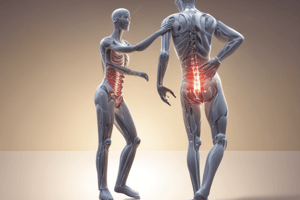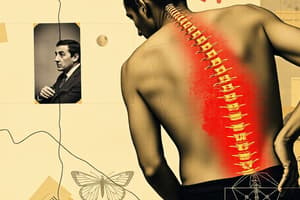Podcast
Questions and Answers
What is the primary treatment approach usually recommended for Schmorl's nodes?
What is the primary treatment approach usually recommended for Schmorl's nodes?
- Conservative management (correct)
- Epidural steroid injection
- Surgical intervention
- Physical therapy only
What characterizes the presentation of a foraminal disc herniation?
What characterizes the presentation of a foraminal disc herniation?
- Leg symptoms without back pain (correct)
- Back pain with significant leg weakness
- Neurological deficits only in the upper extremities
- Persistent localized pain in the lower back
Which imaging technique is often used for the diagnosis of discal pathology?
Which imaging technique is often used for the diagnosis of discal pathology?
- MRI (correct)
- CT scan
- X-ray
- Ultrasound
What symptom would be a red flag indicating the need for immediate surgical referral in spinal assessment?
What symptom would be a red flag indicating the need for immediate surgical referral in spinal assessment?
Which of the following is a characteristic of disc herniations?
Which of the following is a characteristic of disc herniations?
In the context of discitis, what is the typical cause in adults?
In the context of discitis, what is the typical cause in adults?
Which of the following findings is likely to be associated with degenerative changes in the lumbar spine?
Which of the following findings is likely to be associated with degenerative changes in the lumbar spine?
What is the main purpose of a discogram in the evaluation of disc pathology?
What is the main purpose of a discogram in the evaluation of disc pathology?
What is primarily assessed to determine the therapeutic benefit of an injection?
What is primarily assessed to determine the therapeutic benefit of an injection?
Which type of epidural carries a greater risk of puncturing the dura mater?
Which type of epidural carries a greater risk of puncturing the dura mater?
Facet injections are primarily indicated for which type of pain?
Facet injections are primarily indicated for which type of pain?
When performing a caudal epidural, what is a significant risk if not guided by fluoroscopy?
When performing a caudal epidural, what is a significant risk if not guided by fluoroscopy?
What is the main reason for conducting transforaminal epidurals?
What is the main reason for conducting transforaminal epidurals?
What type of joint structure is depicted in each facet joint?
What type of joint structure is depicted in each facet joint?
Which is true regarding the length of time needed to evaluate the effect of an injection?
Which is true regarding the length of time needed to evaluate the effect of an injection?
Translaminar epidurals are less specific in targeting which aspects of pain management?
Translaminar epidurals are less specific in targeting which aspects of pain management?
What is the primary purpose of medial branch blocks?
What is the primary purpose of medial branch blocks?
Which patient population is least likely to suffer from sacral stress fractures?
Which patient population is least likely to suffer from sacral stress fractures?
What imaging technique is commonly used to diagnose sacral fractures?
What imaging technique is commonly used to diagnose sacral fractures?
Which of the following is considered a red flag in spinal assessment?
Which of the following is considered a red flag in spinal assessment?
In the management of osteoporosis-related vertebral fractures, which of the following is NOT a recommended treatment?
In the management of osteoporosis-related vertebral fractures, which of the following is NOT a recommended treatment?
What type of osteoporotic fracture is described by an exaggerated reduction of the mid-height to posterior height ratio?
What type of osteoporotic fracture is described by an exaggerated reduction of the mid-height to posterior height ratio?
What is a common complication associated with acute spinal conditions?
What is a common complication associated with acute spinal conditions?
What occurs to the afferent nerve supply during medial branch radiofrequency neurotomy?
What occurs to the afferent nerve supply during medial branch radiofrequency neurotomy?
Flashcards
Epidural Injection Types
Epidural Injection Types
Different types of epidural injections include Transforaminal, Translaminar, and Caudal.
Transforaminal Epidural
Transforaminal Epidural
A type of epidural injection, done under fluoroscopy, targeting the specific level; avoids spinal headaches.
Translaminar Epidural
Translaminar Epidural
A standard epidural injection (often fluoroscopy guided) that may not reach the anterior epidural space fully.
Caudal Epidural
Caudal Epidural
Signup and view all the flashcards
Facet Joint Injections
Facet Joint Injections
Signup and view all the flashcards
Facet Joint Anatomy
Facet Joint Anatomy
Signup and view all the flashcards
Facet Joint Innervation
Facet Joint Innervation
Signup and view all the flashcards
Facet Injection Timing
Facet Injection Timing
Signup and view all the flashcards
Schmorl's nodes
Schmorl's nodes
Signup and view all the flashcards
Disc Herniation
Disc Herniation
Signup and view all the flashcards
Foraminal disc herniation
Foraminal disc herniation
Signup and view all the flashcards
Discitis
Discitis
Signup and view all the flashcards
Discogram
Discogram
Signup and view all the flashcards
Cervical Degenerative Disc Disease
Cervical Degenerative Disc Disease
Signup and view all the flashcards
Lumbar Disc Herniation
Lumbar Disc Herniation
Signup and view all the flashcards
Myelopathy
Myelopathy
Signup and view all the flashcards
Zygapophyseal Joint Pain Diagnosis
Zygapophyseal Joint Pain Diagnosis
Signup and view all the flashcards
Confirming Zygapophyseal Joint Pain
Confirming Zygapophyseal Joint Pain
Signup and view all the flashcards
Medial Branch Blocks: Purpose
Medial Branch Blocks: Purpose
Signup and view all the flashcards
Medial Branch Blocks: Limitation
Medial Branch Blocks: Limitation
Signup and view all the flashcards
Medial Branch Neurotomy
Medial Branch Neurotomy
Signup and view all the flashcards
Sacral Fractures: Who's at risk?
Sacral Fractures: Who's at risk?
Signup and view all the flashcards
Sacral Fracture Symptoms
Sacral Fracture Symptoms
Signup and view all the flashcards
Osteoporotic Fracture Types
Osteoporotic Fracture Types
Signup and view all the flashcards
Study Notes
Conservative Management of Spinal Conditions
- Low back pain (LBP) affects a majority of patients who aren't surgical candidates.
- A trial of conservative management is often preferred over surgery.
- Specific diagnoses aren't always given in conservative care, leading to multiple treatment options with limited data.
- Patient history (H&P), goals, concerns, and beliefs are crucial in management.
- Imaging results don't always correlate with symptoms, and normal studies shouldn't rule out appropriate care.
Differential Diagnosis of Low Back and Lower Extremity Pain
- Spinal: Lumbar radiculopathy, facet joint arthritis, neurogenic claudication (due to lumbar spinal stenosis), fracture, and tumor are potential causes.
- Non-spinal: Intrarticular hip pain, piriformis syndrome, peripheral neuropathy, or vascular claudication can also be causes.
Red Flags (General)
- Night pain is a general red flag and should be noted
Neurologic Red Flags
- Bowel/bladder dysfunction (including overflow incontinence) often signifies a true surgical emergency.
- Progressive lower extremity weakness and sexual dysfunction are also significant findings.
Radiographic Red Flags
- Compression fractures, changes in pedicle appearance, new onset spinal malalignment, and changes in disc height with vertebral body end plate erosions should be examined for potential infections
Lumbar Disc Herniation
- Lumbar disc herniation most commonly affects young adults.
- Herniation vs. bulge vs. degeneration are different diagnoses and should be differentiated.
Discal Pathology
- MRI often helps with diagnosis
- Vertical herniation involves an extension through the endplate (superior/inferior protrusion).
- Most common in the lumbar spine and lower thoracic areas
- Commonly seen in adolescents and sometimes older adults following injuries.
- Treatments are usually conservative (such as bracing) to address discomfort and limitations.
- Location/direction of herniation affects symptoms (e.g., parasagittal).
Cervical Degenerative Disc Disease
- Neck pain and radicular symptoms (pain, weakness, or numbness) are common.
Myelopathy
- Clinical and imaging findings are crucial in assessment.
Axial Neck Pain
- Often disc-related in patients under age 55.
Cervical Radiculopathy
- Disc-related in under-55 patients.
- Over-55 patients are more likely to have spinal canal or foraminal stenosis-related.
Cervical Myelopathy
- Specific signs/symptoms are associated.
Non-operative Treatment for Spinal Pain Problems
- Education, physical therapy, activity modifications, bracing, and injections are possible, medications are also needed sometimes.
Medications
- Nonsteroidal anti-inflammatory drugs (NSAIDs) are commonly used
- Other options like opioids (narcotics) and antidepressants may be considered for cases with chronic pain or neuropathic pain.
Diagnostic and Therapeutic Injections
- Different types of injections (e.g., trigger point, epidural, facet joint) are used
- These injections can be both diagnostic and therapeutic, and often used as adjunct treatments.
Efficacy of Epidural Steroid Injections (ESIs)
- Debated effectiveness as a treatment for lumbago (back pain), studies are often inconclusive.
Compression Fractures
- Common in high-risk populations (e.g., military personnel, distance runners, postmenopausal women)
Sacroiliac Joint Dysfunction
- Pain can be unilateral or bilateral, often localized to the posterior pelvis and thigh, or groin.
- Provocative activities and increased walking pace may worsen pain.
- Diagnosis and testing are needed to pinpoint the source of pain.
Diagnostic Testing
- X-rays, CT scans, and MRIs are possible tools for imaging.
- Fluoroscopically guided SI joint injections with local anesthetic are considered a standard diagnostic approach for sacroiliac (SI) joint problems.
Studying That Suits You
Use AI to generate personalized quizzes and flashcards to suit your learning preferences.




